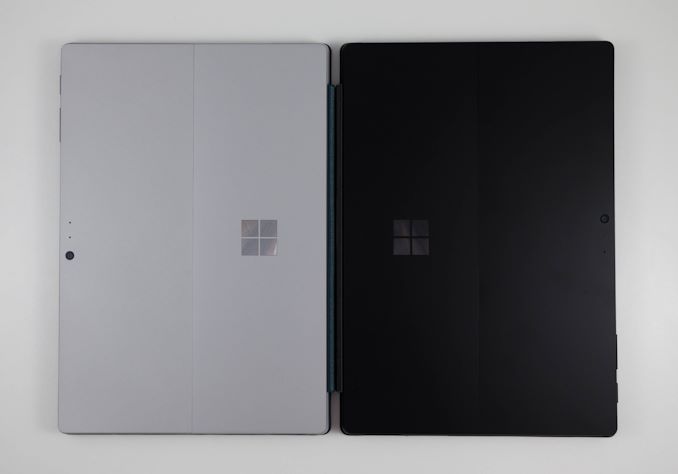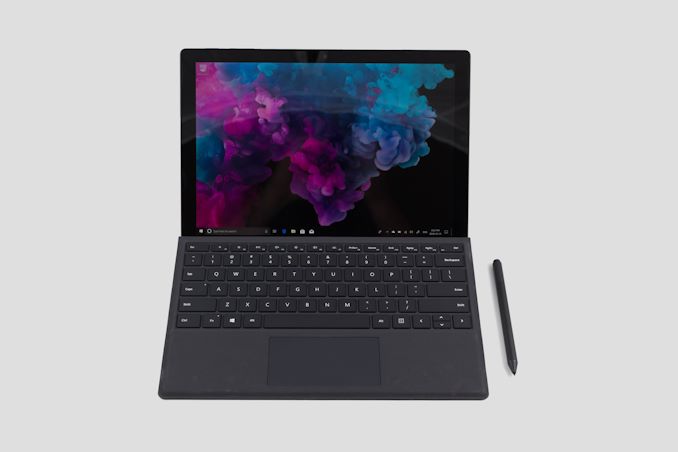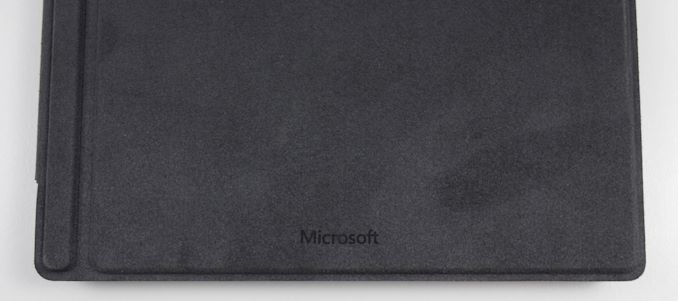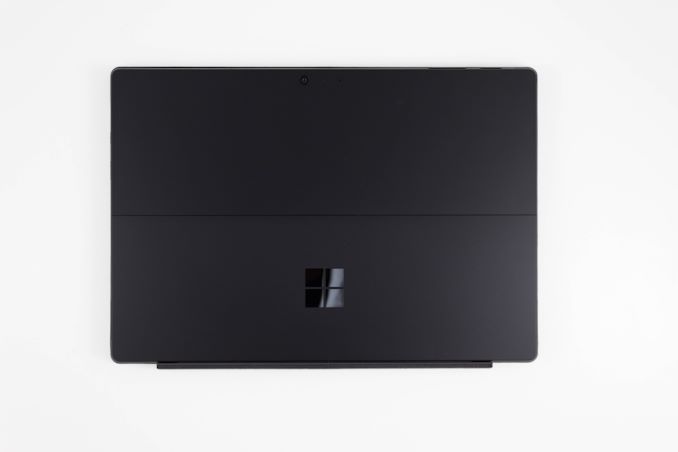The Microsoft Surface Pro 6 Review: More Than A Color
by Brett Howse on October 16, 2018 3:01 AM EST- Posted in
- Laptops
- Microsoft
- Surface
- Tablets
- Surface Pro
- Surface Pro 6
Final Words
At the launch event in NYC on October 2nd, the Surface Pro 6 seemed like a mild refresh of an already established line, and that’s not even necessarily a bad thing. The exterior is more or less identical to the outgoing 2017 model, albeit with a new color option to sit beside the platinum that we’ve seen on all Surface devices for the last couple of years. The pen was immensely improved just last year, and carries over. The alcantara type covers were introduced last year, and once again carry over to this model. There’s still not a USB-C port on Surface Pro, and for no really good reason.
 Surface Pro 2017 (left) in Platinum vs Surface Pro 6 (right) in Black
Surface Pro 2017 (left) in Platinum vs Surface Pro 6 (right) in Black
But after using the device for the last couple of days, there’s more than meets the eye. The big change with Surface Pro 6 is the move to Kaby Lake Refresh, and the doubling of the CPU cores that entails, and unsurprisingly the performance of this model is much better than all previous versions. The lack of an Intel Iris GPU option was unavoidable, since it no longer exists in the 15-Watt range, but even so, the Iris in last year’s Surface Pro was restricted by the low TDP anyway, and as such didn’t always offer the expected performance boost.
Microsoft has also taken the opportunity to improve the already class-leading display in the Surface Pro 6. It’s just as accurate as ever, but now offers a noticeable bump in contrast ratio. If you want an accurate display in the PC space, only Microsoft calibrates every device they sell, and the 12.3-inch display on the Pro lineup offers everything you’d expect in a premium PC, with high resolution, accurate colors, and full sRGB coverage. It would be nice to see Microsoft use Surface as a line to drive HDR adoption, but apparently, we’re not quite there yet. The 3:2 aspect ratio is still the right choice for a device like this, and that’s apparent when you see the competition all adopting the same aspect ratio on their lineups.
The other nice addition this year is even better battery life, with a significant jump across all of our tests. The Surface team achieved that without increasing the rated battery capacity, which if a guess had to be made, would come down to an improved display TFT since the display is still the biggest power draw by a wide margin.
Finally, there’s the new old black color, which we hadn’t seen on Surface since the Surface Pro 2. It looks good, but it does get dirty much quicker than the platinum that they used before, with fingerprints and hand oils showing up very quickly. The other nice benefit of the platinum color is that any scratches to the finish should be mostly masked by the color of the underlying metal, but it’s too early to tell how durable the new black finish will be, so this may or may not be an issue. Likely it will be though, unless you are someone who never scratches a portable device.
This was also our first chance to test out the passively cooled Surface Pro, since we were only able to test the Core i7 model last year, which did feature a fan. The Core i5-8250U in the Surface Pro 6 was able to maintain an average of over 15 Watts of power dissipation indefinitely, although the power would drop periodically to maintain surface temperatures. The added benefit of a completely silent device can’t be overstated either, and unless you really need maximum performance, the fanless model is probably the way to go.
Nothing big has changed for this year, but this version still seems like a nice improvement regardless. If anything, it’s the release cadence of Surface that is the most baffling. It seems like Microsoft is concerned with having another launch go as poorly as it did with Surface Pro 4 and Surface Book, where the Skylake power management issues caused them a lot of grief. When the company moved to Kaby Lake in summer 2017, it fixed those issues, but Kaby Lake was launched in the second half of 2016, meaning Microsoft was selling the Skylake models for far longer than they needed to. Microsoft seems to want to refresh when they want to, but it’s not always to their benefit, and rarely good for their customers, for them to sit on products well after the rest of the competition has moved to the latest products inside. The Surface Pro 6 is launching with Kaby Lake refresh right as Whiskey Lake is launching, which isn’t going to be a dramatic improvement in performance, but it does include hardware mitigations to Spectre and Meltdown which will now not be available in the Surface Pro for the foreseeable future. We are seeing the 2018 Surface Pro 6 launching with the same wireless adapter as the Surface Pro 3 had in 2014, and even in 2014 it wasn’t the best Wi-Fi adapter. The USB-C is another example of where they’ve decided to dig in their heels for almost no reason, since having a second USB port would probably be welcomed by more users than those that want to use mini DisplayPort, even though that’s available over USB-C anyway.
Microsoft’s Surface lineup has always been about a premium device, and to showcase their software, and the Surface Pro 6 delivers on that front. Despite the somewhat questionable update cadence, and even the lack of USB-C, the changes that are here are all very welcome. No one is going to complain about more color options, and the improvements to performance and especially battery life are a boon to all Surface Pro users. These changes bring it to a level that Surface Pro has never been to before. Microsoft is being safe with the Surface Pro, but it was already the class leader, so it’s hard to fault them on that. The Surface Pro 6 is a much bigger update than just a new color.













80 Comments
View All Comments
cfenton - Monday, November 5, 2018 - link
This is just non-sense. I have a 5 year old Macbook Pro I use almost everyday and its battery is fine. I'm sure some will die in 3 years, but most will run just fine for much longer.star-affinity - Wednesday, October 17, 2018 - link
I think it looks great. Some aspects of Windows 10 looks pretty decent too. Too bad a lot of third party Windows software seems made by people who seemingly have little sense of graphic/user interface design an seems stuck with a Windows 95-ish look for their apps.Frenetic Pony - Wednesday, October 17, 2018 - link
"the display on the Surface Pro 6 is one of the best around, with accurate colors, high resolution, and now, even better contrast."The hell it is, the Ipad Pro has had a brighter, higher contrast, HDR display since last year AND has great battery life. My phone has a brighter, higher contrast, better calibrated, HDR display than this has. Lenovo has HDR screens on laptops that work fine, and have a higher PPI to boot. Microsoft is driving around competing for an entire division lower than "best tech possible" and charging a thousand+ dollars for it.
This entire device is pathetic, Whiskey Lake has a USB 3.1 controller built in but MS has deliberately downgraded it, probably just to make it's NEXT Surface seem like a better upgrade. Where's the Thunderboldt 3 ports MS? Intel dropped the licensing, even AMD laptops include it. Calling this device anything other than a deliberately crippled second tier device MS doesn't care about is a journalistic disservice.
Mitch89 - Wednesday, October 17, 2018 - link
"Other than Apple, Microsoft is the only company that controls both the hardware and software sides, and when the Surface lineup launched way back in 2012, Microsoft’s goal was to showcase the advantages of their platform with a premium hardware lineup. "I'm curious what things you think Microsoft have done to take advantage of this in 2018?
domboy - Friday, October 26, 2018 - link
Now if they'd just release a new ARM-based Surface with all these same improvements...c.economides - Saturday, October 27, 2018 - link
Can you please let us know which software you use to measure the thermal performance in this review?If it's proprietary are you able to share it with us?
Thank you.
c.economides - Saturday, October 27, 2018 - link
I am asking because my i5 Surface Pro 6 reproduces the results from all other benchmarks you have run on your test unit, but using prime95 or the powermax stress test, I absolutely havent to replicate your thermals.When all cores are testes (8 threads) the clock stabilizes at 2.4GHz and is a far way from the 2.9GHz you mention. The way I can replicate your results almost 1:1, is if I set the test to 2 threads, then I get a stable power draw of 18W with an average clock of 2.9GHz
albert89 - Saturday, November 10, 2018 - link
Would love to see the same laptop with AMD's APU pro series installed.I have no doubt they can more than match CPU & GPU output at a lower price.
Not that anyone is interested in high performance, low cost laptops these days.
dehwei - Monday, May 13, 2019 - link
When running the battery tests what was the brightness set to? (ie. 40%) It's hard for us to translate nits to windows brightness control. Also was the keyboard attached and was the video playback with audio? If so, what was the volume set to? I am trying to recreate the video playback test with my surface.qiechai - Friday, June 12, 2020 - link
I'm a digital artist . I have a Surface Pro and I use it for drawing in Illustrator and like it a lot! Definitely do not regret the purchase, it saves me hours in terms of workflow. but the pen experience is not as good as the professional drawing tablet . I have a XP-Pen Artist 24 Pro drawing tablet with screen 24" . The pressure on my XP-Pen Artist 24 Pro screen drawing tablet is lighter and smoother especially at the low end, giving better, more natural marks. The Surface is usable, but is a bit of a compromise compared to the Artist 24 Pro . If you are looking for the best pen experience go with the professional graphic tablet.